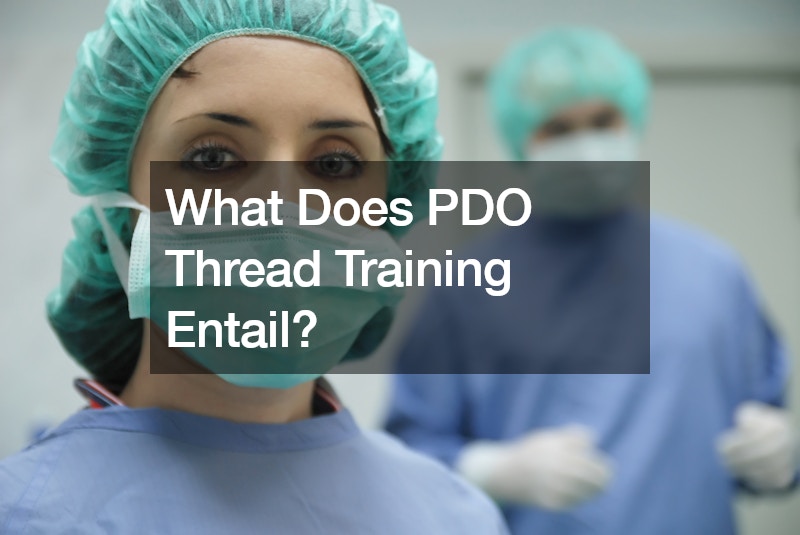Polydioxanone (PDO) thread training is a comprehensive educational process designed to equip medical professionals with the knowledge and skills necessary to perform PDO thread lift procedures effectively and safely. This minimally invasive treatment has gained popularity for its ability to lift and tighten sagging skin, providing a non-surgical alternative to facelifts. Here’s a detailed look at what PDO thread training entails.
Understanding PDO Threads
PDO threads are made of polydioxanone, a biodegradable material that has been used in surgical sutures for many years.
They are inserted into the subcutaneous layer of the skin using fine needles, creating a scaffolding effect that lifts and supports sagging tissues. Over time, the threads dissolve naturally, stimulating collagen production and enhancing skin texture and elasticity.
Objectives of PDO Thread Training
The primary goals of PDO thread training are to:
Educate on the science and mechanism of PDO threads.
Develop hands-on skills for proper thread insertion and placement.
Ensure patient safety and minimize the risk of complications.
Enhance aesthetic outcomes for patients seeking non-surgical facial rejuvenation.
Key Components of PDO Thread Training
1. Theoretical Knowledge
PDO thread training begins with a thorough understanding of the theoretical aspects of the procedure. This includes:
Anatomy and Physiology: Detailed study of facial anatomy, focusing on skin layers, muscles, and fat distribution. Understanding the aging process and how it affects facial structures is crucial.
Types of PDO Threads: Learning about the various types of PDO threads (mono, screw, cog) and their specific applications. Each type serves a different purpose, from skin rejuvenation to lifting and volumizing.
Mechanism of Action: Understanding how PDO threads stimulate collagen production and improve skin elasticity. This involves studying the body’s natural healing response to the threads.
Indications and Contraindications: Identifying the ideal candidates for PDO thread lifts and recognizing contraindications to avoid complications.
2. Practical Training
Hands-on experience is a critical component of PDO thread training. Trainees practice on models or mannequins under the guidance of experienced practitioners. Key aspects of practical training include:
Patient Assessment: Learning to evaluate patients’ skin quality, degree of sagging, and overall facial structure. This helps in creating a customized treatment plan.
Thread Selection: Choosing the appropriate type and number of threads based on the desired outcome and treatment area.
Insertion Techniques: Mastering various insertion techniques, such as the ‘vector’ technique for lifting or the ‘mesh’ technique for collagen stimulation. This involves precise needle insertion and thread placement.
Handling Complications: Training on how to manage potential complications, such as bruising, infection, or thread migration. This includes learning proper aseptic techniques and post-procedure care.
3. Safety and Hygiene
Ensuring patient safety is paramount in PDO thread training. This involves:
Sterilization Procedures: Learning about the importance of maintaining a sterile environment to prevent infections.
Managing Patient Expectations: Educating patients about realistic outcomes, potential risks, and the importance of following post-procedure instructions.
Emergency Protocols: Being prepared to handle adverse reactions or complications during and after the procedure.
4. Aesthetic Principles
PDO thread training also covers the aesthetic principles of facial rejuvenation. This includes:
Proportions and Symmetry: Understanding the principles of facial aesthetics to achieve natural-looking results. This involves studying facial proportions and the golden ratio.
Combining Treatments: Learning how to integrate PDO thread lifts with other non-surgical treatments, such as dermal fillers or botulinum toxin injections, for comprehensive facial rejuvenation.
Follow-up Care: Understanding the importance of follow-up appointments to monitor results, address any concerns, and perform additional treatments if necessary.
Certification and Continuing Education
Upon completion of PDO thread training, practitioners often receive a certification that acknowledges their competence in performing the procedure. However, continued education is essential to stay updated with the latest advancements and techniques in the field. Many training programs offer advanced courses and workshops to help practitioners refine their skills and expand their expertise.
.

